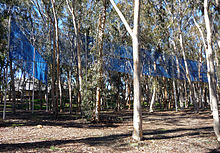Robert Irwin (artist)
Robert Walter Irwin (September 12, 1928 – October 25, 2023) was an American installation artist who explored perception and the conditional in art, often through site-specific, architectural interventions that alter the physical, sensory and temporal experience of space.His early works often employed light and veils of scrim to transform gallery and museum spaces, but from 1975 until his death, he also incorporated landscape projects into his practice.Irwin conceived over fifty-five site-specific projects, at institutions including the Getty Center (1992–98), Dia:Beacon (1999–2003), and the Chinati Foundation in Marfa, Texas (2001–16).The study done by Irwin suggested that: "…all ideas and values have their roots in experience,… they can be held separate at any point and developed directly on the grounds of function and use, both that they in fact remain relative to the condition of both our subjective and objective being."Irwin's philosophy defined his idea of art as a series of aesthetic inquiries, an opportunity for cultural innovation, a communicative interaction with society, and as compounded historical development.In that article, Michael Govan, the director of LACMA who had previously commissioned Irwin to "design our experience" of Dia:Beacon said he believes the book "has convinced more young people to become artists than the Velvet Underground has created rockers.[7][8] "Irwin's new works are composed from unlit six-foot fluorescent lights mounted to fixtures and installed in vertical rows directly on the wall.These installations allowed for an open exploration for artist and viewer of an altered experience created by manipulating the context of environment rather than remaining with the confines of an individual work of art.Other artists involved in the Light and Space movement include John McCracken, James Turrell, Peter Alexander, Larry Bell, Craig Kauffman, Doug Wheeler, and Maria Nordman.Using the entire project space, Irwin suspended a white scrim 10 feet from the ground and attached shimmering stainless steel wires to the wall.[11] Suspended between the floor and ceiling, his Full Room Skylight - Scrim V (1972/2022) comprises two sheets of translucent fabric stretched in a “V” shape across two connected galleries; from overhead, the fabric is illuminated by abundant natural light beaming through the skylights, both concealing and revealing the surrounding architecture depending on variables such as brightness, time of day, and the viewer's vantage point.[13] A permanent wall installation in the entrance corridor of the Allen Memorial Art Museum, the dimensions of Untitled (1980) exactly repeat those of the deep-set windows just opposite.[16] Trifecta (Joe's Bar & Grill), a three-story permanent light installation at Swiss Re's corporate headquarters in Fort Wayne, Indiana, was inaugurated in 2012.The three-story-tall acrylic column, built decades ago but never given a proper home due to a series of unforeseen circumstances, refracts light and cast colors as the sun moves through the lobby.[17] The fabrication of the columns and the technical issues related to the material, were all executed by Jack Brogan, a central character in the evolution of the techniques in the Light and Space Movement.[20] Other installations by Irwin included; Fractured Light – Partial Scrim – Eye Level at the Museum of Modern Art, New York (1970–1971); Black Line Room Division + Extended Forms at the Whitney Museum, New York (1977); 48 Shadow Planes at the Old Post Office Pavilion, Washington, D.C. (1983); Ascending at the Musee d' Art Moderne de Ville, Paris, France (1994); and Double Diamond at the Musée d'Art Contemporain, Lyon, France (1997–1998).His 1983 work Two Running Violet V Forms, two crossing blue-violet, plastic coated wire fences fixed with high poles, is featured as part of the Stuart Collection of public artwork on the campus of the University of California, San Diego.He also exhibited internationally: "Kompas IV" at Stedelijk Museum in Eindhoven, with other artists (Larry Bell and Doug Wheeler), at the Tate Gallery in London, and Documenta in Kassel in Germany.


Robert George IrwinLong Beach, CaliforniaLa Jolla, CaliforniaPaintinginstallation artsite-specific artLight and SpaceNational Academy of Designinstallation artistsite-specificGetty CenterChinati FoundationMuseum of Contemporary Art, Los AngelesMuseum of Contemporary Art San DiegoGuggenheim FellowshipMacArthur FellowshipAmerican Academy of Arts and LettersBaldwin HillsLos AngelesDorsey High SchoolUnited States ArmyOtis Art InstituteJepson Art InstituteChouinard Art InstituteUniversity of California, San DiegoStuart CollectionLawrence WeschlerVenice, CaliforniaJori FinkelNew York TimesMichael GovanVelvet UndergroundFerus GalleryPasadena Art MuseumUniversity of California, Los AngelesPace GalleryUniversity of California, Irvinefluorescent lightJosef AlbersDia:ChelseaKayne GriffinLight Art Space (LAS)electrical tapeanodized aluminumJohn McLaughlinvisual perceptionJohn McCrackenJames TurrellPeter AlexanderLarry BellCraig KauffmanMaria NordmanMuseum of Modern Artstainless steelWalker Art CenterEdward Larrabee BarnesIndianapolis Museum of ArtAllen Memorial Art MuseumMiami International AirportSwiss ReFort Wayne, IndianaSan Diego Federal CourthouseJack BroganLos Angeles County Museum of ArtMarfa, TexasWhitney MuseumOld Post Office PavilionMusée d'Art ContemporainUniversity of WashingtonWellesley CollegeMassachusettsPasadena Civic Center DistrictravineFernand LégerBroad Contemporary Art MuseumChris BurdenUrban LightCor-TenWhitney Museum of American ArtThe Responsive EyeBienal de São PauloKenneth PriceDoug WheelerFort Worth Art CenterFort Worth, TexasMinneapolisFogg Art MuseumHarvard UniversityCambridge, MassachusettsWright State UniversityUniversity of California at Santa BarbaraPalomar CollegeSan Marcos, CaliforniaStedelijk MuseumEindhovenTate GalleryDocumentaKasselKölnischer KunstvereinMusée d'Art Moderne de la Ville de ParisMuseo Nacional Centro de Arte Reina SofíaJohn Simon Guggenheim FellowshipJames D. Phelan awardThomas JeffersonUniversity of Virginia School of ArchitectureSan Francisco Art InstituteOtis College of Art and DesignCentre Georges PompidouJ. Paul Getty MuseumMuseum of Contemporary ArtHirshhorn Museum and Sculpture GardenMuseo Nacional Centro de Arte Reina SofiaMetropolitan Museum of ArtSolomon R. Guggenheim MuseumAlbright-Knox Art GalleryDia Art FoundationBeacon, New YorkLa JollaNine Spaces Nine TreesThe New York TimesThe Art NewspaperWayback MachineLos Angeles TimesDiscogs